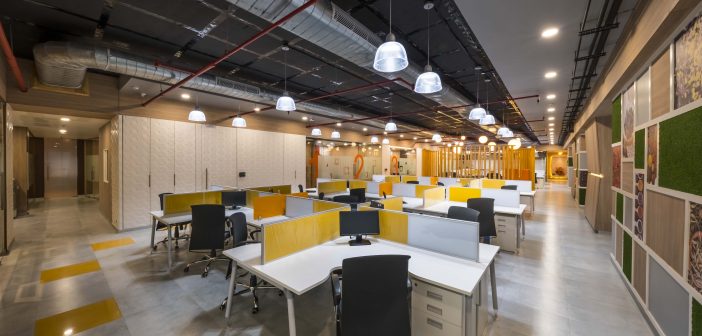RICS India, in association with its knowledge partner Colliers International India released a report ‘Seizing opportunities: Making CRE agile in a dynamic business environment’ at the RICS Corporate Real Estate Summit 2019 in Bengaluru.
The report peaks into the future to explore how occupiers’ preferences are changing and how the industry can seize opportunities.
“In an ever-changing world, where there are several disruptions taking place both locally and globally, the ability of the CRE sector to adapt to change and overcome challenges, is an indication of just how agile businesses are. Only those businesses that move with the changing socio-economic and political environment will be able to survive and perhaps thrive. The Indian market is in the midst of a slowdown, with the residential sector most impacted. While we don’t have a full-blown recession currently, as we did back in 2008, the impact on the CRE market though not currently felt, will only be determined on how deep the slowdown spreads. Additionally, there are factors such as adoption and use of technology, changing occupier requirements and focus on wellness and experiences that are forcing developers and employers to rethink strategy and facilities. This RICS – Colliers report sets the tone of what’s changing, and how CRE may just continue to be the bright shining star of the built environment sector.”,says Nimish Gupta FRICS, Managing Director, South Asia, RICS.
In 2019, Colliers forecasts investments into real estate to be about USD 6.5 billion, with office investments garnering the highest share.Investors, both foreign and Indian, are buoyed by the commercial office sector, which is witnessing robust office demand. Investors are looking to bundle up assets and list them as REITs, capitalising on the solid demand.
In 2018, we noted gross absorption of about 50 million sq ft across major cities in India. Apart from the mainstream real estate assets, we believe that alternative asset classes such as student housing and co-living are seeing increased traction from investors. We believe that these alternative housing models can, in a way, assuage the slowdown in the residential market.
“The next decade will usher in new formats of workplaces, with landlords emerging as wellness creators, where occupiers amalgamate workplaces and technology to increase productivity at workplaces”,says Ritesh Sachdev MRICS, Head of Occupier Services, India and Managing Director, South India at Colliers International.
Foreign investors to rule the market
Since 2008, we note that private-equity (PE) players have pumped nearly USD56 billion into real estate, with domestic investors accounting for 57% of the inflows.Over the last five years, foreign investors have been focused on commercial office assets. Between 2014-H1 2019, Colliers notes that foreign investors accounted for 70.0% of total office investments. Colliers’ future supply projection of 160-180 million sq ft over 2019-2021should support investors’ appetite, who till now faced a lack of investable assets in cities like Bengaluru and Hyderabad.
With India’s first REIT being successful, investors are buoyed by office assets. As per Colliers Research, investors have preferred Bengaluru as their top investment destination among top cities and named Pune as the top destination among emerging cities.
What’s next for domestic investors?
Colliers data indicates between 2014 and Q2 2019, domestic investors accounted for 48% of the total funding in real estate. However, with the non-banking financial company (NBFC) liquidity crisis since September 2018, domestic investors’ funding share into the sector has declined to a 34% share.Over the next two years, we expect to see investors announcing or raising funds specifically for distressed assets.
Over the next two years, we expect to see investors announcing or raising funds specifically for distressed assets. In the coming year, around 63% of the investors said they are likely to invest up to 20% of their investments in distressed assets.
Industrial assets: the sunrise sector?
Between 2017-H1 2019, investors pumped USD1.5 billion into logistics and warehousing assets, with foreign investors accounting for 90% of the inflows.
Commercial office sector on a strong footing
Between 2019-2023, we foresee average annual gross absorption of 50.3 million sq ft, outpacing the annual average gross absorption of the preceding five-year period by about 18%.We expect demand to be driven by Information Technology-Business Process Outsourcing (IT-BPM) occupiers, as well as pharmaceutical, engineering and manufacturing companies, for their global in-house centers (GICs).
We project strong supply in 2019, with almost 68.0 million sq ft coming onboard, hinging on timely completion and approvals from regulatory authorities. Led by the high supply, we forecast vacancy levels to inch upwards by the end of 2019 to 15.1%, from 10.6% at the end of 2018.
Bengaluru emerges as the top location in Asia for the technology sector
During 2019, we expect gross absorption in Bengaluru to touch about 14.0 million square ft, accounting for about 28% of total gross absorption across India’s top seven cities. We believe Hyderabad as an attractive alternative location for technology occupiers, placed seventh on the Asia list. The gross absorption in Hyderabad to touch about 9.5 million sq ft during 2019, for the first time ever, led by technology companies and flexible workspace operators.
Flexible workspaces fast gaining ground
Leasing by flexible workspace operators in 2018 was the largest on record, and we expect this year’s leasing to touch 8.8 million sq ft as operators rush to capture enterprise demand. We believe that leasing by flexible workspace operators should account for about 19% of total gross leasing in 2019, up from 7% in 2017.
GICs continue to ride the tech wave
Colliers International foresees robust demand from GICs, with leasing by GICs across six major cities in India to be in the range of 32.5 million sq ft between 2019 and 2021. Over 2014-2018, occupiers leased about 53.0 million sq ft of office space in multi-tenanted buildings for their GICs. Bengaluru led the demand with about 20.1 million sq ft, followed by Delhi NCR and Hyderabad. Further, we found that companies from the engineering, energy and manufacturing sectors favoured Bengaluru, which accounted for 32% of GIC demand between 2014-2018.
In order to understand how CRE occupiers make decisions, in August 2019, Colliers solicited responses from more than 50 occupiers across major cities in India. Interestingly, the survey revealed that almost 50.0% of CRE executives still face challenges in leasing quality space. The survey also revealed that an employee friendly environment is one of the most important factors, with 76.0% of CRE executives considering it to be the most important factor after cost management.
What’s the next game changer in CRE?
Telecom 5G
With respect to commercial real estate, we believe that the arrival of 5thgeneration of wireless devices should have a transformative effect. In CRE, we believe that foremost, 5G should enhance the capabilities of Internet of Things (IoT) and make buildings better connected, leading to a more robust digital infrastructure. We believe that landlords need to recognise that 5G can benefit their buildings by enabling better connectivity, which could improve the valuation of their buildings.
Electric vehicles
We view India’s vision to adopt electric vehicle (EV) mobility over the next 5-10 years to have a positive impact in not only reducing carbon emissions, but also to enable changes to infrastructure and the real estate sector.
Move over millennials! The Gen Z is here
As a younger workforce enters the job market and as technology evolves, the Indian workplace is transforming into a collaborative and creative environment. We note that innovative design, a seamless assimilation of technology, and wellness facilities for employees are being implemented to drive loyalty and employee satisfaction. Colliers believes that companies are investing time and resources to understand how to retain and attract fresh talent.
Track2Realty is an independent media group managed by a consortium of journalists. Starting as the first e-newspaper in the Indian real estate sector in 2011, the group has today evolved as a think-tank on the sector with specialized research reports and rating & ranking. We are editorially independent and free from commercial bias and/or influenced by investors or shareholders. Our editorial team has no clash of interest in practicing high quality journalism that is free, frank & fearless.
Subscribe our YouTube Channel @ https://bit.ly/2tDugGl





